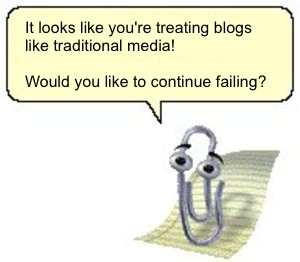
The internet (the blogosphere to be precise) is still a bit of a mystery to many in tech and entertainment. It’s weird to think that companies whose job it is to reach tech-savvy consumers aren’t using this tool correctly, but it’s also no secret that the biggest and most influential companies are often the slowest to adapt. At any rate, they’re learning, but some are learning faster than others. Here I chronicle just a few standout cases.
Note that many companies are bunched under the PR heading, which is in the second half of this post for reasons which will become obvious. Also, it’s a bit awkward talking about the “new media” right after I denied its existence, but for the purposes of this post please just consider it to mean big blogs, news aggregators, and social or bottom-up media.
Doing it right
 Comcast
Comcast
Wait, what? Comcast is doing what right?
Easy, there. I don’t say that Comcast is doing everything right, only that they seem to get the new online power structure. It wasn’t long ago that big companies like this could hide their inadequate service, loppy pricing, and other issues simply by isolating them. Say a Comcast guy put a hole through a priceless heirloom in order to run a cable through it — not exactly far-fetched by Comcast standards. A few years ago, they could give the family free service for a year and that would pretty much be the end of it. Not even a neighborhood newspaper would pick that up. But nowadays, Comcast is on so many naughty lists that the slightest mix-up on their part gets blogged and reblogged until it seems like all Comcast has done lately is drill through antiques.
Fortunately, Comcast gets it here. They recognize that every blog post or minor news item is a seed that may grow and eventually blossom into a meme-flower, strewing bad PR-petals all over the internet. Yeah, that was a bit overwrought, and they probably don’t think of it exactly like that, but I have to get in my extended metaphors when I can. So, case in point: last week a Comcast tech told me that higher-ups in Seattle were trying to pawn off weak, end-of-life cable modems on customers who didn’t know better. It’d hard to say how true that is, but certainly evidence was in favor of it; I’d had one of these modems installed just a few months prior. So I wrote it up.
Within 10 minutes I had a comment from Bonnie, who officially disapproved of the situation, checked up on the facts and corroborated my story, and left her email address — that last bit unwise, perhaps, but noble. She continued to monitor the post, responding to other commenters who voiced other concerns, related or not. In this way Comcast nipped this whole thing in the bud, as already-addressed problems are unlikely to spread, and if my post were to become an attractive one for Google, you’d see the prompt response from Comcast. They get it.
Valve
It shouldn’t come as a surprise that such a new and successful games developer (and publisher) should be doing it right, but there are plenty of examples to the contrary. Valve is a good example, however, because of the way they engage the community. They actually listen, they actually give back, and they actually like doing it. I mean, if you just cold send an email to Gabe Newell, you’ve got a seriously good chance of getting one back. But they also get that you don’t just keep an official blog and throw the community a bone every once in a while. They realize the potential of the blog-and-meme-based intertrons and hence do something like this:

Are you kidding me? It’s the greatest thing ever created, except for this luggage scooter. See, they get that the best advertising isn’t advertising at all. If it’s good, it advertises itself. Valve does the best it can to let their content do just that, and now they’re rolling in cash as the rest of the games industry looks on in exasperation.
Smaller, single-serving companies
Startups and single-device companies like Peek and Drobo are great at individual communication, quick resolution of problems, and other caring and feeding for your blogger issues. I can’t name them all individually, but you little guys are doing it right for sure. Keep it up.
Doing it wrong
 Apple
Apple
Whoa there, calm down. Read first, then flame if you must. The standard “I’m typing this on a mac” preamble applies. Plus, the fact is that whether or not Apple gets or does the blogosphere, their current strategy is working. But my point isn’t that they aren’t successful or suck at PR, just that they’re not utilizing the new media well. And of course, they don’t really need to — the new media pretty much use themselves without Apple’s help. But here’s the thing: despite writing thousands of words on Apple products, sometimes good, sometimes bad, I’ve never heard from them. Not in a comment, not in an email — nothing. Oh, we’ve got someone to talk to if we need to RSVP for a press conference or whatnot, but that’s not the same thing. The fact that I can write a mean-spirited dismissal of iFrame and not hear a word from Apple means they don’t get it or don’t care enough, and either way it’s not a good thing.
Apple is good at doing what I mentioned above: letting the product sell itself. But they don’t engage the community. They don’t need to comment on rumors or address every little thing, but when it’s shown that thousands of Apple laptops have faulty video cards, I think it’s in their interest to go around doing a little damage control.
Yet another glossy, white company that seems to think that because they’ve been successful so far, they don’t need to lower themselves to the level of the blogs. I may be off the mark here because I don’t work at a gaming publication, but it seems to me that Nintendo’s PR is a little bit like a state newspaper (I stop short of saying propaganda, but it’s in the vicinity). One only needs to think of Nintendo Power, the original official Nintendo magazine; it was essentially Nintendo reviewing its own products. Things haven’t really changed since then: they guard their games carefully and issue carefully-constructed PR salvos via official and semi-official sites. Sure, Sony does this a bit on the Playstation Blog, but they’re more along the lines of “Hey, new update for PS3 coming out next week, we’ll let you know what’s up with that later,” while Nintendo is more “Experience the magic that is Wii Music! Miyamoto describes the game as ‘soul-scaldingly good’ in this interview with a Nintendo employee.” See what I mean?
Like in Apple’s case, it doesn’t seem to have affected their success much. But I also think that the ivory tower approach to PR is one that is losing its legitimacy.
 Canon
Canon
After Vincent Laforet shot Reverie and Nocturne on Canon DSLRs, Canon shut them down despite being involved in the process. I understand sometimes there’s a left-hand-right-hand issue in big companies, but this kind of thing is beyond ridiculous. Also, they’re hogging all the 7Ds. They’ll have a 9D out before I get that sucker reviewed. Come on!
Almost every PR company out there

Our… troubles with PR companies are well-known by our readers. CrunchGear relies on them a bit more than TechCrunch, however, since we spend all day sifting through the press release haystack, looking for the occasional needle. Familiarity breeds contempt, but boy have I bred myself some contempt for the standard PR email and press release. The few companies that actually know how to engage a blog or news outlet are like shining beacons on a stormy night, while the dim stars of the rank and file PR drones do little to illuminate the dark.
Current PR practices include such bizarreries as:
- Sending an email to ask if they can send an email
- Not including product photos in a release, then sending 10MB 300DPI TIFF files hours later
- Calling every single thing they put out “revolutionary”
- Reading out loud every word of a presentation they’ve sent, as if we were children
- Leaving other blogs in the address (Dear Engadget!)
- Pitching us for things which are so clearly unrelated to what we cover that it’s insulting
- Asking for a social security number before sending a review item
The list goes on. And on. I don’t mean to exaggerate our own importance (I know this piece is coming off a bit that way), but seriously, know who you’re emailing at least. These kinds of mistakes are so elementary (or so weird) that I have no hope of their being fixed.
So
That’s the end of this little editorial. I wish I could give better advice, but really, it’s not that hard to engage your online audience. Take a look at your company’s practices in this field, if you are in a position to do so, and then look at how the masters are doing it. You don’t have to put together fake comic books and send them to your fans, but it might be nice to at least acknowledge that the new social media exists and should be catered to separately just like any other medium.
This is far from a complete list, it’s just a few impressions I’ve gotten from the last few months of tech-blogger business as usual. Feel free to add to the naughty or nice list in the comments.
Quick update: Apologies if your PR email is in the picture. I didn’t pick those because they were bad, but rather as a representative sample of the deluge of PR we wade through every day.
